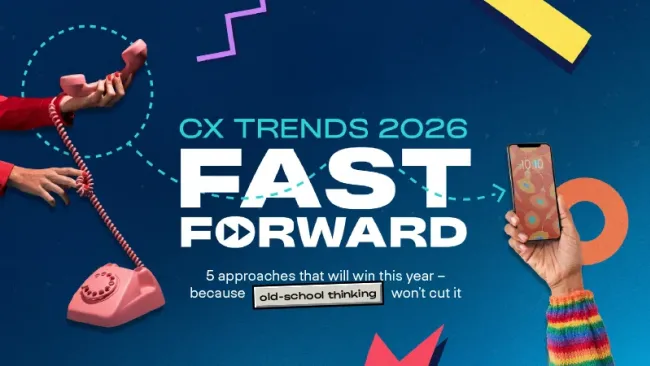When discussing omnichannel strategy, digital is nearly always considered a top priority. More than 40 percent of the entire world has an internet connection, and in the U.S., it’s at 87 percent of the population and growing, according to InternetWorldStats.
While digital deserves to be a leading customer interaction priority for companies, the singular term is itself made up of many channels that continue to evolve at lightning speed. Consumers use different digital channels differently, and organizations must understand how they fit into the overall experience picture before even beginning to think about implementing any omnichannel plan.
Digging deeper into the digital consumer experience, our sister company 1to1 Media conducted a survey with SurveyMonkey of 525 consumers to learn what they mean when they say digital interactions. Digital consumer behavior increasingly means interacting via social and mobile, places where most organizations have yet to create a sturdy customer experience foundation.
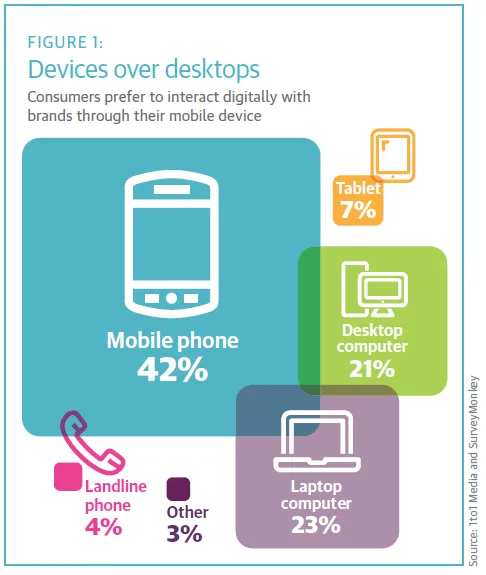
Figure 1 shows that nearly half of consumers surveyed (42 percent) prefer to interact digitally with brands via their mobile device, followed by laptop computers (23 percent), desktops (21 percent), and tablets (7 percent). In addition, 60 percent of respondents interact with mobile apps at least once day, and 57 percent interact with social media websites at least once a day (see Figure 2). And, most consumers (65 percent) browse websites every day.
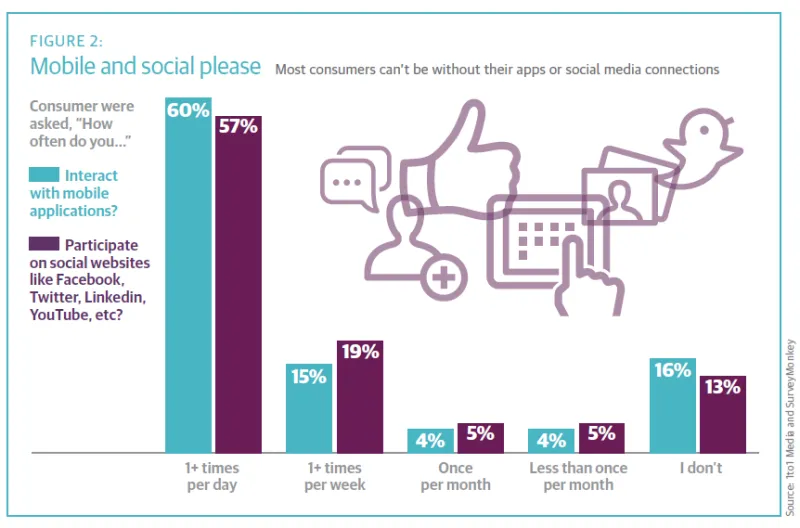
In the age of Amazon, it’s not surprising that consumers interact with retailers most on digital channels. What is surprising is that other industries are seeing an increase in digital consumer interactions, particularly financial services and healthcare (see Figure 3).
Another interesting finding is that telecom companies rank very low on the list. So while they may provide the devices and connectivity to enable digital interactions, they aren’t necessarily providing the digital experiences consumers are looking for. Also of note is that nearly 20 percent of consumers still don’t want to interact digitally with companies in any of these industries.
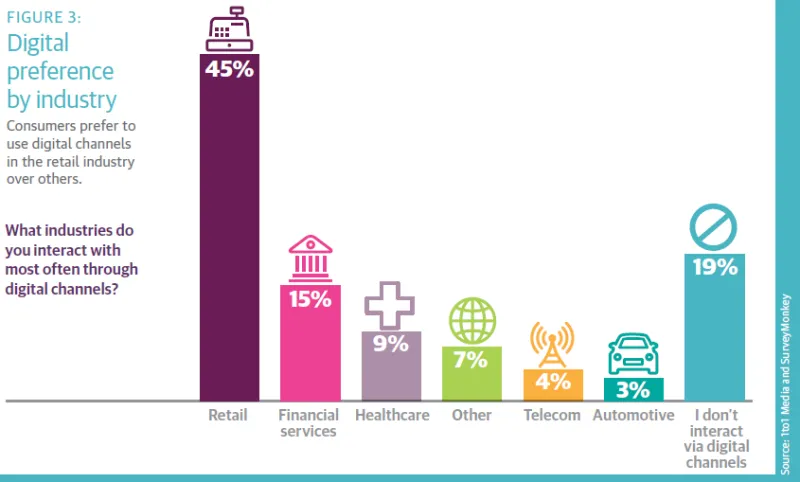
Digital has become so engrained into consumers’ daily activities that it may influence their decision to remain customers of a particular brand. The survey found that 17 percent of consumers would stop doing business with a company that didn’t have a strong digital presence, and another 40 percent would consider ending the relationship (see Figure 4).
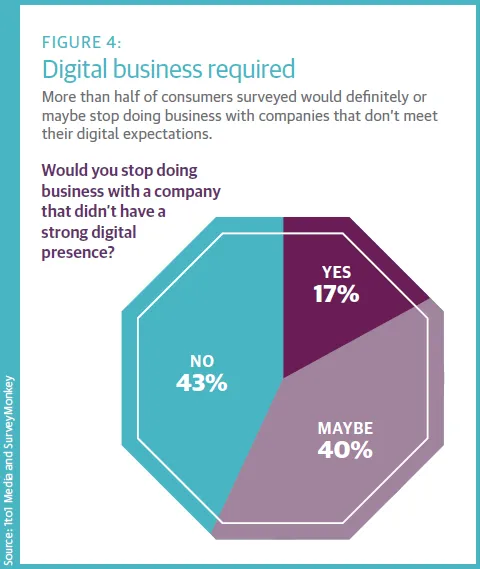
Get your omnichannel wheels turning
Clearly there is a critical need for digital customer experience excellence in channels as varied as social media, mobile, and websites. Those experiences can’t live in a vacuum, especially for companies who also operate in traditional channels like physical stores, branches, and contact centers. A true omnichannel approach to customer experience is required.
Unfortunately, however, we see many companies bypass the foundational elements of customer experience in favor of the shiny object—digital tools. This approach is misguided and prone to failure because it means the company lacks a strong customer experience foundation on which to grow. If you simply ignore the customer experience basics in other channels and move to digital channels, it will be a waste of money. There will be no substance behind the activity, and customers will see right through it.
Mobile apps are a perfect example. Many companies rushed to develop their own apps without first understanding how customers engage with the brand. As a result, many brand apps never received much notice from customers. In fact, 90 percent of consumer branded apps have fewer than 10,000 downloads, according to mobile marketing firm Carnival.
To succeed with emerging channels, you can’t leapfrog over the basics. Instead, you must build a solid customer experience foundation from which to incorporate all interaction channels. This means setting up people, processes, and technology to identify, differentiate, customize, and interact with customers to meet their needs and resolve their issues. The specifics of the foundation may be defined differently for individual companies, depending on their unique business and unique relationships with customers.
Once the elements of great experience are defined, the company is then ready to apply the elements to all the channels, digital or otherwise, and connect them so they provide a seamless experience for the customer, regardless of which channel they use or how often they move among them (see Figure 5). In our definition, the experience is the hub and the channels are the spokes, which together form a strong wheel to propel business forward (see Figure 6). Digital is just one piece of the omnichannel puzzle.
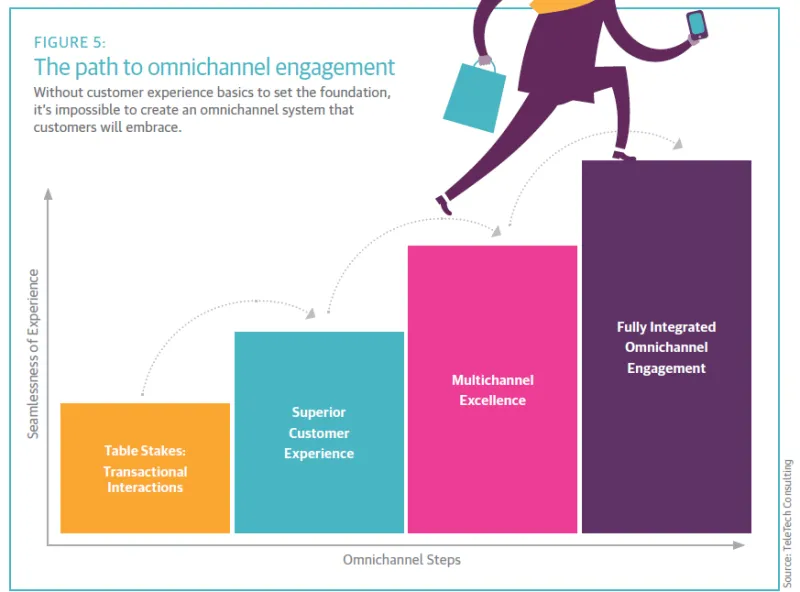
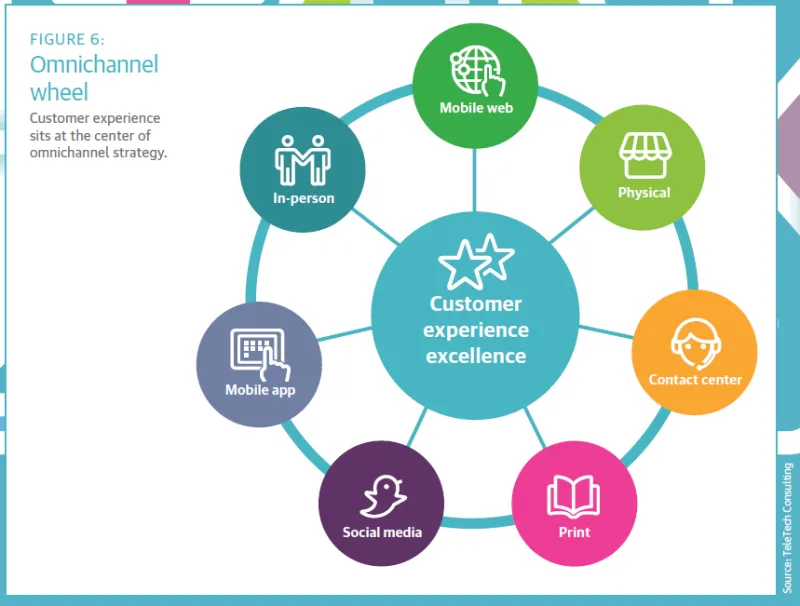
Operationalizing engagement
Many companies understand that they need to move down the path toward digital and omnichannel success because it’s what their customers demand. Yet these same companies are struggling with how to implement new strategies when they also have to contend with legacy systems and operations. So many firms are still locked into activities like inbound calls over antiquated land lines, for example, even though customers increasingly prefer to engage in digital ways. We see these sorts of challenges across the entire set of customer experience enablers—organization, process, data and information, and technology.
For companies straddling the old world with the new, we recommend a few steps to operationalize a more omnichannel approach. It’s not necessary to turn the entire ship around. Sometimes all it takes is to move just a few degrees to have an impact that resonates with customers.
A key element behind successful transition to omnichannel engagement is to shift the culture of the company to be more customer centric. The ability of companies to pivot so as to align how they operate to meet new customer expectations is critical to success.
Culture shift isn’t easy, but because everyone’s a customer, the idea isn’t all that foreign to employees. Executives must commit to and be consistent with creating a culture of customer focus to gain buy-in from employees and build momentum. It must be more than lip service. With the right culture in place, decisions will be made naturally that improve the customer experience across all channels, whatever they may be. What gets measured, what gets recognized, and what gets prioritized must reflect customer-based culture.
In addition, be sure to understand what your customers actually want. Assuming they want mobile and social when they actually prefer talking to a real person on the phone or in person can do more harm than good, for example. Recent research conducted by TeleTech found that 61 percent of consumers prefer that businesses invest in improving first-call resolution as a top priority, followed closely by training employees to be empowered and knowledgeable (60 percent), and reducing complexity when solving an issue during an interaction (44 percent). Digital and mobile improvement ranks twelfth on a list of 13 consumer investment priorities.
Tap into the voice of the customer, conduct customer assessments relating to their needs, value, and behavior dimensions, and solicit their ideas about innovations and areas of opportunity. Bring their voice into any strategic decision-making to ensure that investments are made in the right places.
Build on quick wins
Along with these high-level adjustments, a few small tactical changes may help start to build momentum around customer-centered, omnichannel activities. Chat tools, for example, are a good way to get your digital feet wet. On the consumer side, 64 percent expect live chat options to be available already, according to a Moxie research report. Yet firms aren’t meeting those expectations. According to Gartner, chat represents only 2 percent of overall interactions, and will grow to 10 percent by 2018. From the company resource perspective, the operational challenges of chat can easily be overcome. Add-in widgets alleviate potential IT headaches, and existing customer service and sales associates can be trained to support customers through chat.
Online self-service options can be further expanded as well, giving consumers more options and control over the interaction. But it’s got to be done correctly. A clunky, confusing system will turn off customers. It’s got to be designed with the user experience in mind, not just as a way to reduce operating costs or deflect calls without understanding what the consumer experiences. For example, a strong, up-to-date knowledge management system will be critical for users to be able to access information to resolve their issues quickly and accurately. Companies should evaluate their current self-service tools to determine how they align with customer needs and expectations.
Beyond self-service, simple tools that give customers more say in their interactions can also improve the experience in the long run. An online appointment-based customer service model, for example, gives customers choice in when to interact with reps about certain issues. They choose the best time to work with an associate, and the company can find the most appropriate employee to work with the customer. It switches focus from inbound response to outbound proactive strategy. This model can be applied to both B2C and B2B businesses.
These are just a few examples of how small changes can have a big impact on the customer experience, and they help set up the foundation on which to build omnichannel excellence. The idea of moving down the path toward omnichannel success can be overwhelming and may paralyze an organization. The important thing is to act. Customers won’t wait, especially for digital excellence, and won’t put up with disparate channels and interactions.





